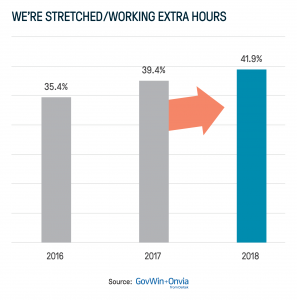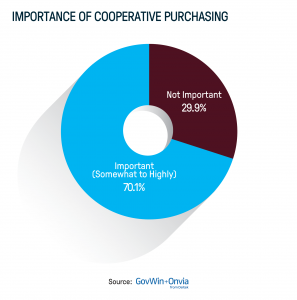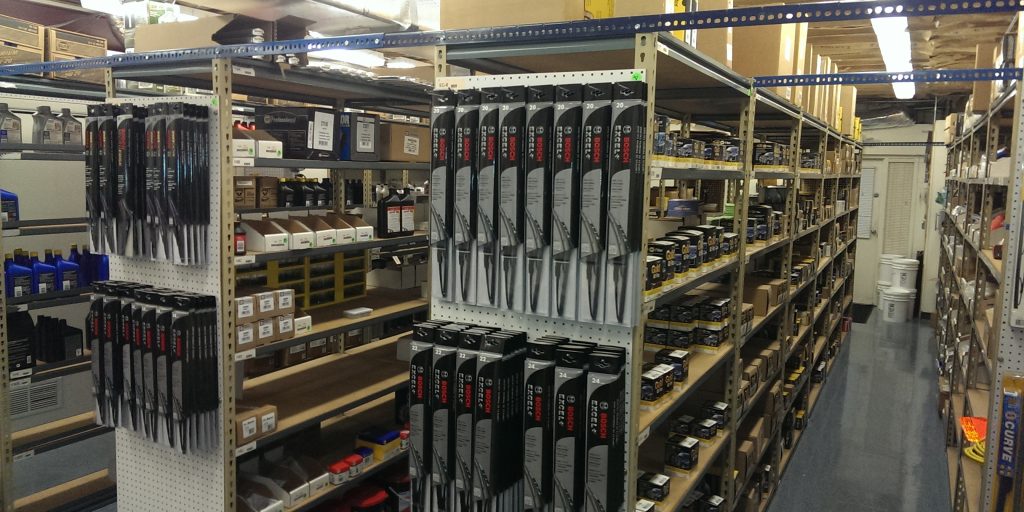Purchasing powerfully
Editor’s note: All charts that appear in this story come from Deltek’s Survey of Government Procurement Professionals 2018 and the Survey of Government Contractor Sales Expectations 2018-19.
Ask any government office, “what do you think of your purchasing processes?” and the answers can vary from “slow and cumbersome” to “hard to navigate and understand.” It might be surprising to many, that procurement professionals will often agree with that assessment. Public procurement rules and regulations, the need for competitive and transparent processes and ever-changing landscape of government needs can push any team to its limits. So, it’s not necessarily purchasing’s fault. Many teams were significantly reduced during the past recession, with resource levels never fully re-staffed upon the economic recovery, and the so-called ‘silver tsunami’ of increasing boomer retirements, with a lack of knowledgeable replacements, is also adding to the problem.
In a recent government survey by Gov+Win from Deltek, procurement teams across the nation were asked about their top challenges.
“The percentage of government purchasing staff that report being over-worked has steadily climbed in our survey from 35 percent in 2016 to 42 percent in 2018, and to some extent, is starting to look more like a tech start-up than a government bureaucracy in expectations for hours and workloads,” Paul Irby, principal research analyst at GovWin IQ SLED says.
The other top challenges cited in the survey include budget and resource constraints, lack of time to conduct in-depth research, ever-increasing workloads and most recently, lack of quality suppliers bidding on available contracts.
As a result, procurement teams are responding in recent years with innovative techniques and new ways to meet the growing and diverse needs of their organizations. Cooperative procurement is one of those available tools to increase productivity while maintaining high standards and best practices.
What is cooperative procurement?
The concept of cooperative procurement isn’t only of interest to the procurement department. By becoming better informed on the process, leaders across the organization can experience efficiencies and a wide range of benefits to meet operational challenges through cooperative purchasing.
The idea is simple. A lead agency, or cooperative organization, typically conducts the solicitation, allowing other agencies to “piggyback” on the resulting contract to obtain those same goods and services. One of the primary benefits is that it combines multiple agency requirements on a single contract to aggregate spend volumes, thus raising the purchasing power of each participating entity. The result? A small school district in Montana can garner the same purchasing power of a large city like San Diego.
“Entities also benefit from the technical specifications development used in the solicitations for equipment and services not routinely purchased,” Ronnie Barnes, from HGACBuy Cooperative Purchasing, says. “Furthermore, cooperatives are the repository and defender of all related solicitation and contract documents. All credible cooperative organizations provide these documents, with supporting materials, to assist entities in providing transparency to the process.”
Cooperative purchasing for commodities reached “mainstream” status among local governments several years ago, judging from the Deltek survey of procurement staff. Nearly 87 percent of governments are currently using cooperatives with increasing growth. The growing level of participation is due primarily to a greater degree of adoption and utilization, as cooperative choices continue to expand into new offerings for technology, services and construction. Wayne Casper, former chief procurement officer for the State of Arizona and Director of Procurement for Tucson, Ariz., and currently Group vice president with National IPA, a national cooperative purchasing organization, has seen the expansion of cooperative purchasing over his decades of public procurement experience. He says, “cooperative purchasing has evolved to become a procurement best practice in local government. The utilization of cooperatives allows the purchasing teams to better focus on best value and become strategic contributors to the success of their organizations.”
State of Hawaii drives savings in car rental contract
Building on the idea of cooperative contracting, Hawaii created such a state-wide contract for intra-state car rentals. Nineteen state agencies, various local municipalities and 170 boards and commissions coordinate government activities across eight main islands. For government employees working on the mainland, the option to jump into a government-issued car and drive across the assigned jurisdiction is generally taken for granted. In the Aloha State, going from one island to another takes a lot more coordination. Flights must be arranged, and upon arrival, a rental car must be used to travel across the island, since bus service isn’t always available or convenient. There is the additional challenge of the competing tourist market, and having a rental car readily available, at a reasonable cost.
The solution? A state-maintained cooperative contract for rental car services. Used by multiple agencies, “Hawaii State Cars“ provides a dedicated easy-to-use reservation system with guaranteed compact car upon arrival when conducting government business. According to Bonnie Kahakui, eProcurement Supervisor for the State Procurement Office, “drivers have benefitted from the expedited check-in process with pre-negotiated features like guaranteed availability and gas-fill up. In addition, the contract has made it easier for travel coordinators to quickly make reservations, even on last-minute trips.” The rental car companies – Alamo, Enterprise and National – can afford to offer deeply discounted rates due to the steady revenue from a government contract vs. the ever-fluctuating tourist market. Most importantly, savings have resulted. Contracted in September 2017, the contract has been used for a combined 19,000 rental days with an overall savings of $300,000, when compared to open market rates.
City of Boise fleet operations streamlined
For any large municipal fleet operation, maintaining a large auto parts inventory has traditionally been part of the operational strategy. However, this often places a burden on the budget – with thousands of dollars in inventory sitting on the shelves, or sometimes becoming obsolete, as fleet vehicles and equipment are upgraded. It also requires staffing resources, who may be divided across several operational duties. In today’s age of online ordering and same-day delivery, maintaining large on-site inventories is becoming a practice of the past.
Boise, Idaho, envisioned a better way of doing business by consolidating fleet resources and embarking on an out-sourced inventory management system. With a wide array of fleet vehicles, ranging from pool cars to heavy equipment, their approach was that any outsourced effort must simplify the process, and have one point of contact for parts to service all fleet assets. The selected company is expected to conduct the due diligence for tracking down the right parts from multiple suppliers, coordinating deliveries, providing comprehensive reports and issuing one invoice. In addition to minimizing the fleet parts inventory, the accounting and payment portion has also been streamlined from hundreds of invoices from multiple companies to one master invoice from one company each month. Even setting up this type of operation has been simplified, with the bid and award process for the integrated business solution for parts and service readily available through a cooperative contract.
“By outsourcing our parts management to NAPA Integrated Business Solutions, we negotiated a one-time sale of our inventory assets for an immediate $64,700 in cash flow and reduction in overhead cost,” Craig Croner, Boise’s administrative services manager and recipient of the Government Fleet GFX 2015 Leading Fleet of the Year, says. “Furthermore, we were able to gain efficiencies in wrench turning hours by reducing our technician involvement in parts processing from 14 percent down to 3 percent of actual time. Our technicians are now more involved on the actual shop floor, adding value and increased production time. Efficiencies have been realized in reduced city-wide administrative functions by consolidating payment statements, yearly inventory functions, and warranty processing handled by the supplier.”
Construction repairs in shorter time frames
 Tinley Park, Ill., is unique in its location within two counties – Cook and Will. The Village is approximately 16 square miles and is home to almost 60,000 residents. When asked about the changing role for government facilities teams, Terry Lusby, the village’s facilities and fleet superintendent states “It’s very fast paced, and you have to stay up-to-date on all current facility issues, particularly when it affects operational needs.”
Tinley Park, Ill., is unique in its location within two counties – Cook and Will. The Village is approximately 16 square miles and is home to almost 60,000 residents. When asked about the changing role for government facilities teams, Terry Lusby, the village’s facilities and fleet superintendent states “It’s very fast paced, and you have to stay up-to-date on all current facility issues, particularly when it affects operational needs.”
In prioritizing the workload for most facility teams, the top priority is life safety issues. A recent example was the Village’s police station, where the rooftop air handler units were virtually on their last leg, resulting in heating and cooling issues within the building. With the extreme cold or hot weather in this midwest location, it was considered a life safety issue. In addition to protecting employees and visitors to the site, another pressing issue was this location also housed prisoners, who have state and federal requirements related to their safety.
“This was a big issue we had to get taken care of this quickly as possible,” Lusby says. “So, we used a cooperative contract, called Gordian’s ezIQC® solution to switch out the two rooftop units in a very time efficient manner.”
Also known as job order contracting (JOC), established by local, competitively-awarded contracts through cooperative purchasing networks, this construction solution is used by states and many municipalities for renovation and alteration work, responding quickly to emergencies, addressing a backlog of deferred repairs and straightforward new construction.
With only eight team members, competing priorities within Tinley Park can often create a backlog in repairs.
“I think a lot of facilities managers find themselves in a predicament – when there’s an emergency or something is pressing – the decision is made in haste before the plan is well thought out or the contractor is selected without being fully vetted,” Lusby says. “Later, when the work doesn’t get done correctly, you find yourself going back and spending additional monies and resources on something that could have been done better, but the process was rushed.”
Through a cooperative JOC contract, the village now quickly onboards local contractors who are already vetted, with the necessary skill sets to complete projects needed across the jurisdiction.
Achieving sustainability goals while reducing costs
 Tucson, Ariz., was looking for an environmentally responsible, cost-effective way to provide janitorial and sanitation supplies to meet the City’s goals for conservation and sustainable development. The scope expanded beyond the environmental responsibility, as it also impacted the health and safety of employees and the community. The city issued a request for proposals which resulted in a national cooperative contract solution that could also be utilized by other municipalities. The ultimate award to NETWORK Services Company, serviced through its local distributor, WAXIE Sanitary Supplies helped support their sustainable procurement practices. There were added value propositions of product and process, best practice training, robust reporting, and consultations with industry experts to manage responsible use and minimize waste.
Tucson, Ariz., was looking for an environmentally responsible, cost-effective way to provide janitorial and sanitation supplies to meet the City’s goals for conservation and sustainable development. The scope expanded beyond the environmental responsibility, as it also impacted the health and safety of employees and the community. The city issued a request for proposals which resulted in a national cooperative contract solution that could also be utilized by other municipalities. The ultimate award to NETWORK Services Company, serviced through its local distributor, WAXIE Sanitary Supplies helped support their sustainable procurement practices. There were added value propositions of product and process, best practice training, robust reporting, and consultations with industry experts to manage responsible use and minimize waste.
“Awarding a janitorial and sanitation supply contract to be used by all departments of the City helped reach our sustainability goals,” Marcheta Gillespie, the city’s former director of procurement who oversaw this contracting effort, says.
With an increase of 20 percent more spend toward green purchasing, the cost reduction in the first year of the contract was $73,000. By consolidating the spend under one contract, the number of orders was also reduced by 19 percent, thus reducing ancillary environmental impacts such as fuel use, noise and traffic. With a shift toward efficient towel and tissue products, and right-sized can liners, waste and maintenance costs have also been significantly reduced.
On the other side – supplier perspective
 The Deltek survey showed that 59 percent of those surveyed companies participate in cooperative contracts, with a full 70 percent admitting they consider cooperative contracts “important” to their ability to grow their state and local government revenues in the coming year. Why would a company want to enter into a contract that might minimize profit margins, with potential value-added requirements? Because responding to individual city, county and other local agency bids and RFP’s can be very cumbersome, time-consuming and expensive. By responding to one RFP for a national or regional cooperative contract, a supplier has the ability to leverage the awarded contract to gain government business without having to respond to hundreds of individual efforts. In addition, with the easier avenue of contracting with private industry vs. the public market, some suppliers are opting out of the more cumbersome government route. A recent phenomenon is occurring in some jurisdictions across the country is the difficulty of finding qualified vendors to respond to their solicitations. Choosing an already awarded cooperative contract may be an option to eliminate the time spent on creating a comprehensive bid document, then putting it out on the street and experiencing the risk of having no suppliers respond.
The Deltek survey showed that 59 percent of those surveyed companies participate in cooperative contracts, with a full 70 percent admitting they consider cooperative contracts “important” to their ability to grow their state and local government revenues in the coming year. Why would a company want to enter into a contract that might minimize profit margins, with potential value-added requirements? Because responding to individual city, county and other local agency bids and RFP’s can be very cumbersome, time-consuming and expensive. By responding to one RFP for a national or regional cooperative contract, a supplier has the ability to leverage the awarded contract to gain government business without having to respond to hundreds of individual efforts. In addition, with the easier avenue of contracting with private industry vs. the public market, some suppliers are opting out of the more cumbersome government route. A recent phenomenon is occurring in some jurisdictions across the country is the difficulty of finding qualified vendors to respond to their solicitations. Choosing an already awarded cooperative contract may be an option to eliminate the time spent on creating a comprehensive bid document, then putting it out on the street and experiencing the risk of having no suppliers respond.
Newly released Harvard white paper touts the benefits
“Cooperative Procurement: Today’s Contracting Tool / Tomorrow’s Contracting Strategy,” a white paper recently published by Harvard’s Kennedy School of Government, concludes that “Cooperative (coop) purchasing clearly can add value.
The challenge for chief procurement officers and elected officials is to achieve the right balance where they receive value from coop purchasing while retaining the ability to control overarching policy and specialized local conditions. The primary advantage for acquisition officers will be the opportunity to push routine work off to nationally-accepted practitioners and/or to secure from those coops specialized expertise and, in turn, free up their time and funds for more complex and unique issues.
“Cooperative procurement can truly be a liberating and effective tool in the strategic sourcing toolbox for public procurement professionals,” Jeremy Schwarz, director of operations and procurement for Sourcewell says.
According to the research, “procurement professionals across the country want to develop relationships with vendors, and cooperatives provide a platform for a mutually beneficial relationship. Some cooperatives have established vendor advisory boards, which work with vendors to establish best practices and address “pain points” they face in the typical procurement process.”
“Our white paper reinforced my former experience… in the belief that creative approaches to procurement can incorporate expertise and facilitate innovation,” Stephen Goldsmith, former mayor of Indianapolis and former deputy mayor of New York City says. “As the cooperative movement matures, it brings in new tools and approaches that can offer hope for beleaguered procurement shops aspiring to both get beyond the commodity work and to better understand new technologies.”
Released in October 2018, the white paper was commissioned by the National Cooperative Procurement Partners Association which is taking the lead in providing educational content, advocacy and leadership in this ever-expanding industry.
Tammy Rimes, MPA, is the executive director for National Cooperative Procurement Partners and former purchasing agent for San Diego, Calif.





















Remember however, that no all purchasing cooperatives are the same, especially when it come to construction services. Here’s what to look for when considering renovation, repair, sustainability, maintenance, or minor new construction services in a cooperative.
1. Owned and managed by a Government Agency – Beware of those owner by private entities and/or that carry excessive fees.
2. EDGAR Compliance – Assure that the Cooperative has EDGAR compliance to assure proper fiscal due diligence.
3. Locally researched cost data – Locally researched cost data is far more accurate and cost effective than using national average reference cost data with/without location factors. Learn more… https://www.4bt.us/joc-resources/
It’s important to note that all purchasing cooperatives are not the same, especially when it come to construction services. Here’s what to look for when considering renovation, repair, sustainability, maintenance, or minor new construction services in a cooperative.
1. Owned and managed by a Government Agency – Beware of those owner by private entities and/or that carry excessive fees.
2. EDGAR Compliance – Assure that the Cooperative has EDGAR compliance to assure proper fiscal due diligence.
3. Locally researched cost data – Locally researched cost data is far more accurate and cost effective than using national average reference cost data with/without location factors. Learn more… https://www.4bt.us/joc-resources/